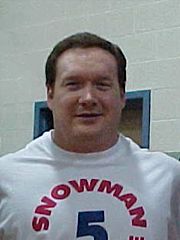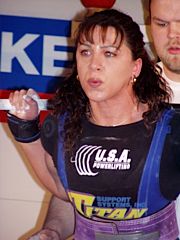 Via Powerlifting Watch : more pictorial and video goodness from the Arnold, this time courtesy Ano Turtiainen. Enjoy.
Via Powerlifting Watch : more pictorial and video goodness from the Arnold, this time courtesy Ano Turtiainen. Enjoy.
Results tagged “powerlifting”
Via Powerlifting Watch : Ed Coan training the squat (culminating with a raw set at 685). This is guaranteed to get you in the mood for a serious workout.
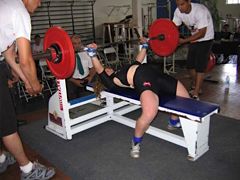 Take a wander over to the blog of Brazilian powerlifter Marília Coutinho.
Take a wander over to the blog of Brazilian powerlifter Marília Coutinho.
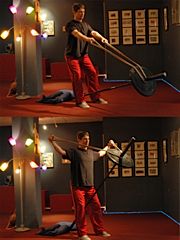 A shoulder injury, cooler weather and plenty of reading to do here on Straight to the Bar :
A shoulder injury, cooler weather and plenty of reading to do here on Straight to the Bar :
- Methods of Max Effort : Dave Tate looks at the many ways of working out on ME days. Great reading.
- One arm partial row : Bud Jeffries is partial to partials (with notable results). So, apparently, is MMA champion Mike Bruce.
- Looking for a bit of reading material? Something to watch? Something to listen to perhaps? Try Blaine's rundown on running books, a great compilation video of russian powerlifter Vladimir Kalinichencko at work, or the first part of an interview with world champion Priscilla Ribic on the latest Pure Powerlifting podcast.
- Bending : want to try your hand (hands, really) at bending but not quite sure how? Chuck Halbakken tells all.
- Bonus : Strap Rear Flys (pictured at left). Another very interesting exercise from Physical Subculture.
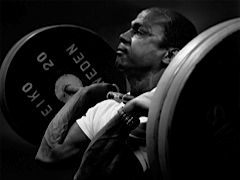
Photo © 2001 David Roberts
. Via Powerlifting Watch : a great site by Andrei Kovalenko detailing powerlifting meet history back to 1971. A superb resource.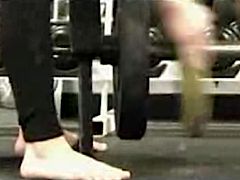 Would they be like these (particularly the second one)? Not bad at all.
Would they be like these (particularly the second one)? Not bad at all.
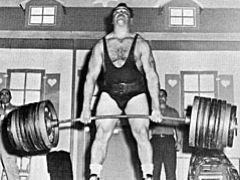 Tom Furman points to a piece on American Powerlifting Evolution discussing legendary Canadian powerlifter Benoit Cote. Great stuff.
Tom Furman points to a piece on American Powerlifting Evolution discussing legendary Canadian powerlifter Benoit Cote. Great stuff.
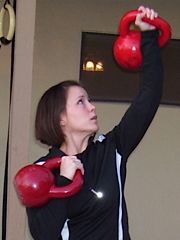 A few of this week's blog finds :
A few of this week's blog finds :
- Jim's Powerlifting Place : as the name suggests, this is a serious powerlifting workout blog.
- A second chance : once again, a serious powerlifting workout blog.
- Sara Cheatham's blog : kettlebell training. Lots of great workout notes.
- Yoana's blog : some serious kettlebell training.
- Royce's rants and stuff : kettlebell training and, well, stuff.
- Powerlifting journal : training diary of a very mysterious NC powerlifter; training for the APF Granite City Barbell Meet in Mt. Airy, NC.
- Physical Subculture blog : notes from a small gym in Sacramento.
- Strength Athletics : training notes from Canadian strongman Steven Stackpole.
- Fitness Fixation : fitness and health writing.
- Diary of a Madman : Tales from suburban kettlebell instructor and US Marine Will Williams.
- Sarah Bennett : two years of kettlebell training can take you a long, long way.
- Mpower : a training diary for Crossfit-style workouts.
- Knowledge of Health : exactly what it says. An in-depth look at health.
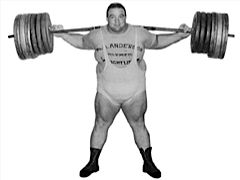 Just came across a brief history of Powerlifting over at Hickok Sports. For a somewhat more comprehensive look, take a wander over to Powerlift Evolution.
Just came across a brief history of Powerlifting over at Hickok Sports. For a somewhat more comprehensive look, take a wander over to Powerlift Evolution.
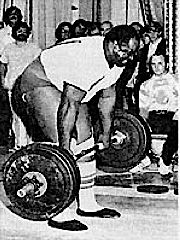 Via Powerlifting Watch : Legendary powerlifter Jim Williams has passed away at the age of 65. Truly a great loss.
Via Powerlifting Watch : Legendary powerlifter Jim Williams has passed away at the age of 65. Truly a great loss.
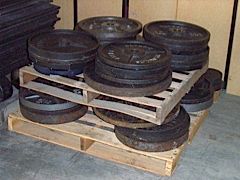
Standard vs Olympic
When I began lifting weights - a little under 3 years ago now, although I gave them a few brief tests a decade or two ago - I started the home gym off with a bench, bar, dumbbells and plates. These bars were standard (rather than Olympic); as were all of the plates.
It was not until several months later I became aware of the differences, and began switching over to Olympic bars and plates. So what are the differences?
There are six key differences between Standard and Olympic plates. If you're aiming to compete in a powerlifting or Olympic lifting event, the Olympic bars and plates are an obvious choice. However, they may still be worth considering for their other differences. These are :
diameter (of hole, bar) : Standard bars are less than 1" in diameter, whilst Olympic bars are a more noticeable 2" or so. This instantly increases the grip component of many lifts.
length (of bar) : a Standard bar measures either 5', 6' or 7' (the 6' seems to be the most common); an Olympic one is always 7'. The extra length increases the stabilisation component of many exercises.
weight (of bars) : a Standard bar weighs in at around 10kg, an Olympic one a much heftier 20kg. The weight of an Olympic bar is easily included in calculations for total weight, as it equals the same as a large (20kg) plate. Whilst there are both heavier and lighter plates available, the 20kg (44lb) is common.
cost : the major factor in the favour of Standard bars and plates is the cost, which is generally considerably cheaper than the Olympic counterparts.
comparison : for both calibration and historical reasons it is usual to see Olympic bars and plates used in competition. However, even if you're not competing, it's great to be able to instantly compare your own lifts to those you've seen on the platform.
threading and knurling (of bars) : Standard bars often have threaded ends (for the collars), whilst Olympic bars are typically smooth throughout this section. Olympic bars also differ in the knurling on the bar, which is similar from bar to bar, unlike the knurling on Standard bars. This knurling is used not only for grip, but to line your body up in various exercises.
availability : another factor that should be considered when purchasing new bars or plates is their availability. Both new and second-hand bars and plates are more easily found in Standard sizes. When it comes to buying plates - particularly at this time of year - a great place to start is the nearest garage sale. Joe Skopec has a great article on cleaning up the rusty iron you often come across in such a sale.
Fat bars
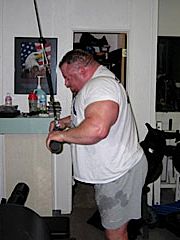
One thing to keep in mind - especially if you're fattening up your own bars - is that the plates themselves will be unchanged (whether Standard or Olympic); only the bar itself will be altered. For a very simple way of doing this, take a look at a couple of pictures of my chinning bar being given the fattening treatment. A similar process was then employed to thicken up a couple of dumbbell handles.
Hooks
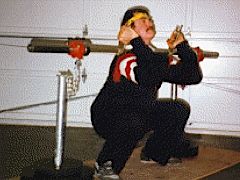
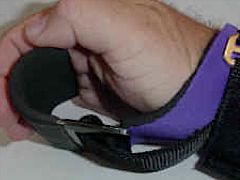
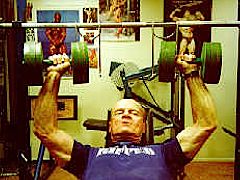
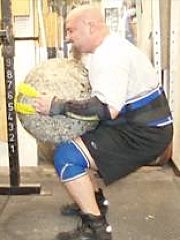
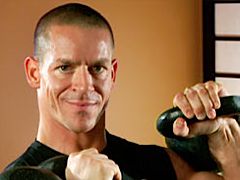 A few more training blogs have been added to my bookmarks over the past few days, including :
A few more training blogs have been added to my bookmarks over the past few days, including :
- Steve Cotter's Full Kontact Kettlebells (kettlebells)
- Kkuhomen's Training Log (kayaking)
- Jedd Johnson's (The Diesel Crew's) Napalm's Corner (grip, powerlifting)
- Carol's Triathlon Training Blog (triathlon)
- Eric Hörst's Climbing and Training Blog (climbing)
Enjoy.
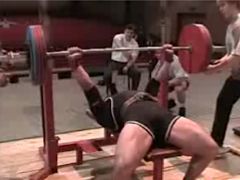 This week saw the birth of 2007, a cricket whitewash (for the first time in 86 years) and the following stories here on Straight to the Bar :
This week saw the birth of 2007, a cricket whitewash (for the first time in 86 years) and the following stories here on Straight to the Bar :
- Glossary - strength training equipment : before this month's article series on training equipment gets into full swing, a few key pieces of strength training equipment were defined. This will undoubtedly become part of a much larger, growing resource.
- Harold Sakata : a fascinating bio of the Olympic weightlifter and professional wrestler who is perhaps best known to most as Oddjob - Goldfinger's golf caddy and manservant.
- Top 5 weightlifting injuries : watching these was a bit like slowing down to see a car accident. Slightly nauseating, but very difficult to resist.
- Bungee backpack : with a reduction in the force felt by the wearer of up to 86%, this backpack looks set to be in the arsenal of long-distance hikers and runners everywhere.
- Virtual Meet : the first 'Geographically dispersed powerlifting meet' is only a matter of weeks away. Get ready.
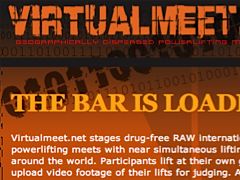 Under the Bar's Kris Lindqvist came up with a very interesting idea a while ago : a 'Geographically dispersed powerlifting meet'; in which participants would compete in their own local or home gyms assisted by as little as a video camera and a power rack.
Under the Bar's Kris Lindqvist came up with a very interesting idea a while ago : a 'Geographically dispersed powerlifting meet'; in which participants would compete in their own local or home gyms assisted by as little as a video camera and a power rack.
The official site for the event, VirtualMeet.net, tells all :
Participants lift at their own gyms and upload video footage of their lifts for judging. All meets are currently open with overall results determined by relative strength formula. Once the results are in, an edited meet video is made available for free download.To allow most anyone to compete most anywhere, power racks and other devices that increase safety without affecting a successful lift are allowed; qualified spotters are simply not found everywhere. The dress code is a T-shirt and shorts (or non-supportive singlet). A belt is the only allowed piece of powerlifting equipment. The technical rules are standard, with special attention paid to the depth of the squat (IPF rules) and the pause on the bench press. Participation is free.
If you haven't already signed up (entirely free), do so simply by leaving a comment on the original tsampa.org post or sending an email to Kris (address at the bottom of that same page). Very much looking forward to it.
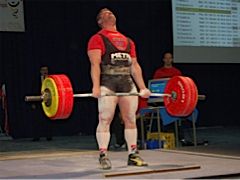 Via Powerlifting Watch : photos from the 2006 IPF Powerlifting World Championships in Stavanger, Norway.
Via Powerlifting Watch : photos from the 2006 IPF Powerlifting World Championships in Stavanger, Norway.
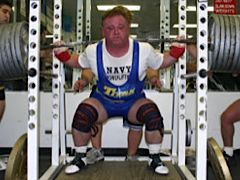 Jack Reape has a great article on increasing squat depth - no matter which Powerlifting federation you favour. Amid the great advice is this :
Jack Reape has a great article on increasing squat depth - no matter which Powerlifting federation you favour. Amid the great advice is this :
I highly recommend a drill that my friend Pavel Tsatsouline teaches in his Strength Stretching video. It's a squat performed facing the wall and should be done in front of a mirror, preferably in the cardio section of your favorite gym. Face the mirror with your toes an inch or two away from the wall in a wider than normal stance. Stick your butt back and your knees out and lower yourself as deep as you can go. Hold your hands out to the sides with your palms up to keep your sternum up as in the normal squat.
I like this one; though I'm at least spared the pain of having a full-length mirror in the home gym. Luckily a blank wall does the trick admirably.
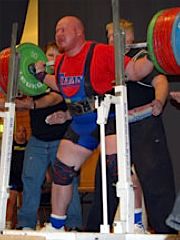 Via Powerlifting Watch : video [streaming, 3.1mb .flv download via KeepVid] of Finnish superheavyweight Ove Lehto's record squat. 425 kg (935 lb) of fun.
Via Powerlifting Watch : video [streaming, 3.1mb .flv download via KeepVid] of Finnish superheavyweight Ove Lehto's record squat. 425 kg (935 lb) of fun.
